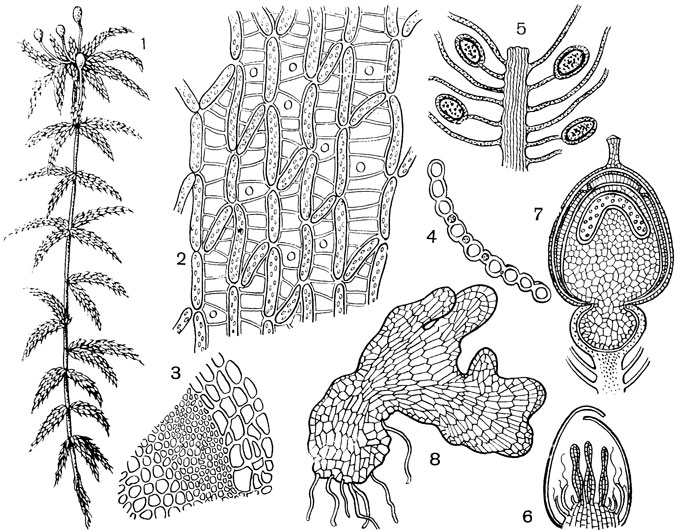Order Sphagnum, or Peat, Mosses - Sphagnales
Order Sphagnum, or Peat, Mosses - Sphagnales
This order consists of one family, Sphagnaceae, with a single genus, Sphagnum, comprising over 300 species, of which there are more than 40 species in the flora of the Soviet Union. Sphagnum is one of the characteristic landscape plants. It forms vast massifs on peat bogs and overgrown lakes. Less significant, but continuous, like a carpet, sphagnum tufts are often found in low places and hollows in damp forests and lowland meadows. Sphagnum mosses are the main peat formers.
Sphagnum(Sphagnum). It is not difficult to keep live sphagnum in the laboratory during the winter for study and observation. Sphagnum tufts are placed in jars with rainwater or water from the places where they were taken. The amount of water in the jars is adjusted to the natural habitat of each species.
Sphagnum is one of the calcephobic (calcium-avoiding) plants. To trace its relationship to calcium, put a small tuft of sphagnum in hard water or in water with a suspension of chalk in it and observe the condition of the plants.
Possessing a huge moisture capacity, sphagnum retains atmospheric precipitation and thereby accelerates the process of waterlogging of forests and meadows that began with its appearance.

The moisture capacity of sphagnum can be observed in the following small experiment. Air-dried sphagnum plants are placed in a low vessel with water so that the tops of the plants rise above the vessel. Water rises up the plants and their weighted heads hang down, and the water begins to drip in drops from the hanging top.
External structure(Fig. 52). Let us carefully select one sphagnum plant from the turf and examine it using a magnifying glass. Sphagnum stem branched, weak. The main stem and, in particular, the lateral and apical branches are densely covered with very small leaves. Lateral branches often sit in bunches; some of the branches protrude in different directions, others hang along the stem, sticking to it. The short branches of the apex sit especially densely, forming a head, which in many species of sphagnum differs in color: yellow, brown, brown or red (Fig. 52, 1). Throughout the stem, rhizoids are completely absent, for sphagnum, with its aquatic lifestyle, and not needed.
Sphagnum mosses stand upright in swamp water and grow indefinitely with their apical buds. The lower, old parts of the moss gradually die off and turn brown, while some side branches, having separated due to the death of the stem, continue to grow further as independent individuals. Such is the vegetative propagation of sphagnum.
The internal structure of the leaves(Fig. 52). Sphagnum is characterized by a different structure of stem and branch leaves. Having separated the lateral branch of the sphagnum, we scrape off the leaves from it with a dissecting needle and, after preparing the preparation, examine them at low and then at high magnification of the microscope.
Branch leaves of sphagnum are round-triangular in shape, pointed, attached to the stem with a wide base. They are single-layered, do not have veins and differ from the leaves of all other plants in an elegant evenly reticulated structure. The coherent network of the leaf is made up of long, narrow, slightly curved chlorophyll-bearing cells; between them is placed one significantly larger, dead, colorless aquifer, with ringed thickenings and pores on the surface. The leaves of different types of sphagnum differ in the details of the structure of aquifer and chlorophyll-bearing cells (Fig. 52, 2). Thus, two tissues from alternating assimilation and aquifer cells are combined in the structure of a sphagnum leaf (Fig. 52, 4).
reproduction(Fig. 52). The sphagnum leafy plant is a bisexual gametophyte. Reproductive organs are formed near the top, on the branches of the head. Antheridial branches often differ from vegetative ones in color, as well as in a greater thickness and more dense arrangement of leaflets, in the axils of which oval antheridia sit on long legs. Shortened, bud-like archegonial branches are harder to find. At the very top of them, under the cover of delicate covering leaves, they sit in groups of archegonia (Fig. 52, 5, 6).
Spherical sporogons ripen in mid-summer. A mature, dark brown sporogon opens with a falling operculum, the boundary of which is marked as an annular groove.
Let's prepare a cut passing through the box and through its short thick leg, which goes into the outgrowth of the twig. This outgrowth is called a false leg. A significant part of the cavity of the box is occupied by a large-celled tubercle, called the column. A dome-shaped sporangium sits on it (Fig. 52, 7). Sphagnum spores are large, rounded tetrahedral, covered with thick yellow exine.
From sphagnum spores, pregrowths grow in the form of green lobed plates with rhizoids. New sphagnum plants grow from the buds that appear on the pregrowth. Thus, the pregrowth is the initial phase of the gametophyte (Fig. 52, 8).

